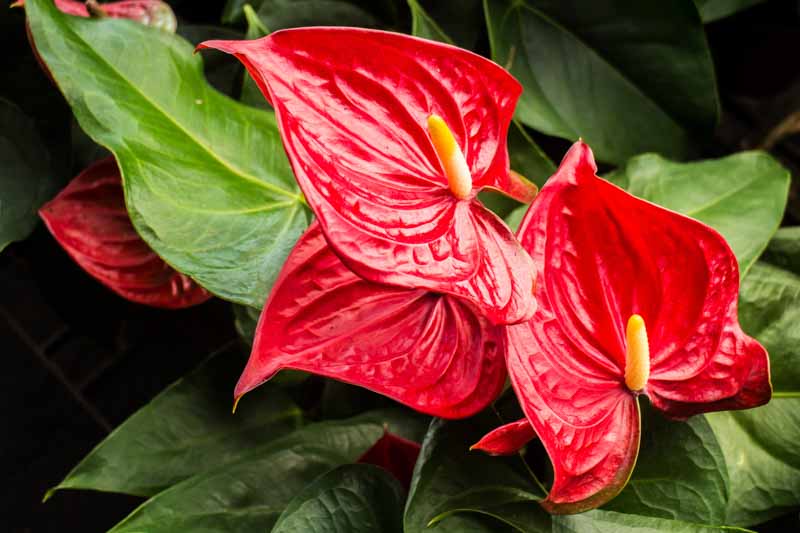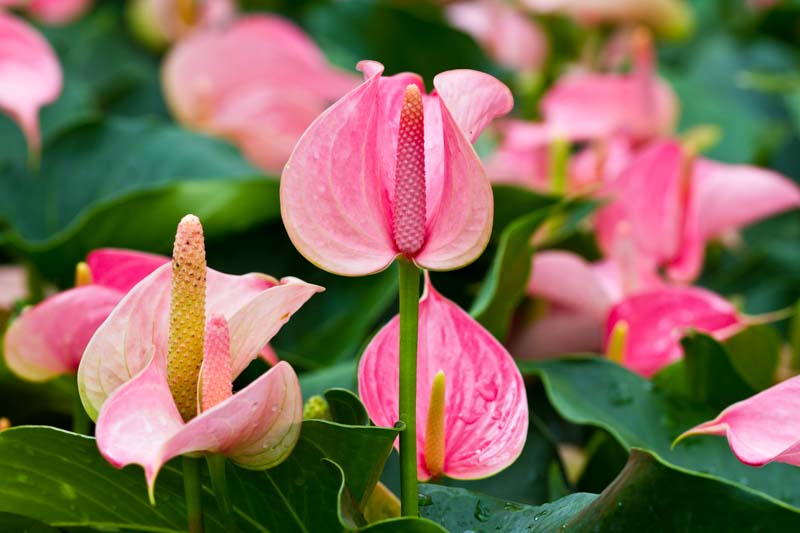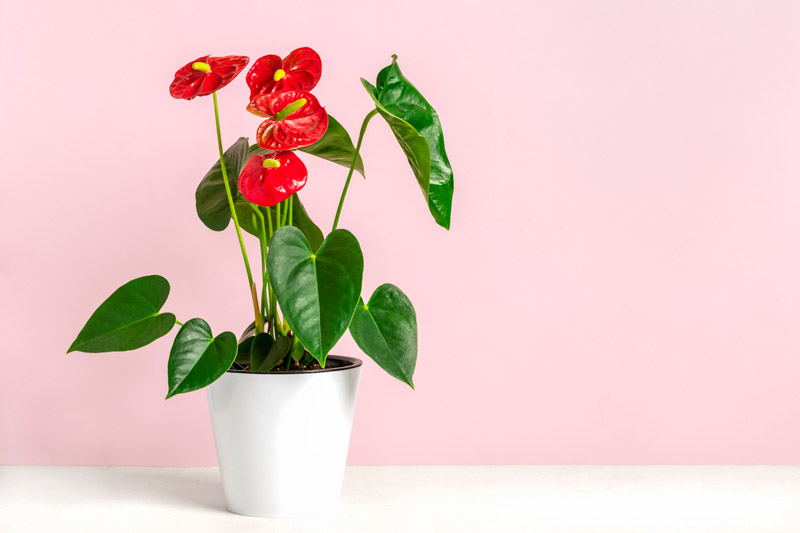Tail Flower, Flamingo Flower, Flamingo Lily, Painter’s Palette
Noted for its long-lasting flowers, Anthurium andraeanum, commonly known as Flamingo Flower or Laceleaf, is a stunningly beautiful and popular houseplant known for its vibrant, heart-shaped flowers and glossy green leaves. This plant adds an exotic touch to any interior setting and is relatively easy to care for, making it a favorite among both novice and experienced gardeners. It also ranks as a top choice among tropical flowers.
Anthurium andraeanum features large, glossy, heart-shaped leaves and striking flowers, which consist of a colorful, waxy spathe (often mistaken for the flower) and a spadix (a spike of tiny flowers). The spathe ranges in color from bright red, pink, and orange to white, making it highly decorative.
Native: This tropical perennial is native to Colombia and Ecuador in South America, thriving in the humid, shaded understories of rainforests. Anthurium plants belong to the arum family (Araceae), along with Zantedeschia (Calla Lily), Caladium (Angel Wing), or Colocasia (Elephant Ear).
Plant Type and Habit: It is an evergreen, herbaceous plant that grows as an epiphyte in its natural habitat, meaning it typically grows on other plants or trees rather than in soil.
Size: In indoor settings, Anthurium usually grows 12-18 inches tall (30-45 cm) and 10-12 inches wide (25-30 cm), with its lush foliage creating an attractive display.
Flowers: Anthurium andraeanum is celebrated for its long-lasting, vibrant blooms, each lasting several weeks. The plant features glossy, heart-shaped spathes, up to 6 inches long, in stunning shades of red, pink, orange, or white, alongside a protruding, usually white or cream spadix of tiny flowers, offering an exotic elegance to any space. With ideal conditions, one plant can produce 4-6 flowers per year. Post-bloom, it may bear berry-like fruits with seeds, a rarer occurrence indoors.
Foliage: The evergreen foliage of ovate to arrow-shaped, dark green leaves, up to 12 in. long (30 cm), arise on long stems from the plant crown and is attractive year around.
Hardiness: Anthurium plants thrive in USDA hardiness zones 11-12 and prefer temperatures between 65°F to 80°F (18°C to 27°C), with high humidity.
Award: Recipient of the prestigious Award of Garden Merit of the Royal Horticultural Society.
Uses: Cherished by florists around the world for its sheer tropical look and long-lasting cut flowers (up to 4 weeks), Anthurium deservedly grabs all the attention. It is also popular in homes and offices for its air-purifying qualities.
Toxicity: The plant is toxic to pets and humans if ingested, causing irritation to the mouth and gastrointestinal tract due to calcium oxalate crystals.
Invasiveness: Not considered invasive outside its native range, especially when grown as an indoor plant.
Benefits: Apart from its decorative appeal, Anthurium andraeanum is known for its air-purifying capabilities, helping to remove toxins from indoor environments.

Growing and caring for this tropical flower involves providing conditions similar to its native tropical environment.
Light: Anthurium thrives in bright, indirect sunlight. Avoid direct sun, which can scorch the leaves.
Soil: Use a peaty potting mixture with organic matter such as compost or ground bark to enrich it and improve drainage.
Water: Water when the top inch of soil feels dry. Anthuriums prefer consistently moist soil but not waterlogged conditions. Reduce watering in the winter.
Temperature and Humidity: Maintain temperatures between 65°F to 80°F (18°C to 27°C). Protect from drafts and sudden temperature changes. Aim for 60-80% humidity. Use a humidifier, mist the plant regularly, or place the pot on a pebble tray with water to increase surrounding humidity. Suitable for outdoor growth in zones 11-12, Anthurium plants may not survive temperatures below 40°F (4°C).
Fertilization: For optimal growth, apply liquid fertilizer weekly to your anthurium during its growing season. Opt for a phosphorus-rich fertilizer, diluted to 1/4 strength, to stimulate flowering and ensure healthy development.
Pruning: Remove yellow or damaged leaves and faded flowers to encourage new growth and maintain a tidy appearance.
Repotting: Repot every 2-3 years or when the plant becomes root-bound. Spring is the best time for repotting. Plant with the crowns just above the surface and cover with sphagnum moss to prevent the uppermost roots from drying out.
Propagating anthuriums through stem cuttings and division is relatively simple:

Anthurium, while relatively easy to care for, can still encounter a few pests, diseases, and common problems.
Aphids: Small, green, or black insects that suck sap, leading to distorted growth. They can be rinsed off with water or treated with insecticidal soap.
Spider mites: Indicated by fine webbing on the plant and discolored leaves. Increase humidity around the plant and treat with miticide or neem oil.
Mealybugs: These white, cottony pests feed on plant sap, weakening the plant. Remove them manually with a cotton swab dipped in rubbing alcohol or use insecticidal soap.
Scales: Scale insects are stubborn pests that attach to plant stems and leaves, sucking sap and weakening the plant. They appear as small, brown, dome-shaped bumps. Control with horticultural oil or insecticidal soap.
Root rot: Caused by overwatering or poor drainage, leading to brown, mushy roots. Prevent by ensuring well-draining soil and careful watering. Affected plants may need repotting into fresh soil after removing rotted roots.
Fungal leaf spot: Keep foliage dry, provide good air flow, and remove affected leaves; apply fungicides for persistent problems.
Yellowing Leaves: Overwatering, poor drainage, or nutrient deficiencies can cause leaves to yellow. Adjust watering habits and consider a balanced fertilizer.
Browning Leaf Tips: Often a sign of low humidity, excessive fertilization, or fluoride in water. Use distilled or rainwater and ensure adequate humidity.
Leggy Growth: Insufficient light can lead to sparse, leggy growth. Move the plant to a brighter location with indirect sunlight.
Flower Production Decreases: Insufficient light or nutrient imbalance can reduce flowering. Ensure bright, indirect light and use a phosphorus-rich fertilizer to encourage blooms.

Yes, Anthurium is an excellent indoor plant. It’s known for its striking flowers and glossy green leaves, adding a splash of color and tropical flair to any interior setting. It also thrives in indoor conditions with adequate light and humidity.
Water Anthuriums when the top inch of soil feels dry to the touch, typically once a week. They prefer consistently moist soil but do not tolerate waterlogging. Reduce watering in the cooler, less active growth period during winter.
Place your Anthurium in a spot with bright, indirect light, such as near an east-facing window. Avoid direct sunlight, which can scorch its leaves. The plant also appreciates high humidity, making bathrooms or kitchens ideal locations if they receive sufficient light.
To encourage continuous blooming: Provide bright, indirect sunlight. Maintain high humidity. Use a phosphorus-rich fertilizer diluted to 1/4 strength every week during the growing season. Keep the plant in a warm spot, with temperatures between 65°F to 80°F (18°C to 27°C). Ensure the pot has adequate drainage to prevent root rot.
Anthurium plants are toxic to humans if ingested. They contain calcium oxalate crystals, which can cause irritation to the mouth, throat, and gastrointestinal tract. It’s advisable to handle the plant with care, especially around children and pets.
Yes, Anthurium plants have been noted for their air-purifying qualities. They can help remove toxins such as ammonia, formaldehyde, and xylene from the environment, making them a beneficial addition to indoor spaces for improving air quality.
| Hardiness |
11 - 12 |
|---|---|
| Climate Zones | H2 |
| Plant Type | Houseplants, Perennials |
| Plant Family | Araceae |
| Common names | Flamingo Flower |
| Exposure | Partial Sun |
| Season of Interest |
Spring (Early, Mid, Late) Summer (Early, Mid, Late) Fall Winter |
| Height |
1' - 2' (30cm - 60cm) |
| Spread |
10" - 1' (25cm - 30cm) |
| Spacing | 12" (30cm) |
| Maintenance | Low |
| Water Needs | Average |
| Soil Type | Loam, Sand |
| Soil pH | Acid, Alkaline, Neutral |
| Soil Drainage | Moist but Well-Drained |
| Characteristics | Cut Flowers, Plant of Merit, Showy, Evergreen |
| Garden Uses | Patio And Containers |
| Hardiness |
11 - 12 |
|---|---|
| Climate Zones | H2 |
| Plant Type | Houseplants, Perennials |
| Plant Family | Araceae |
| Common names | Flamingo Flower |
| Exposure | Partial Sun |
| Season of Interest |
Spring (Early, Mid, Late) Summer (Early, Mid, Late) Fall Winter |
| Height |
1' - 2' (30cm - 60cm) |
| Spread |
10" - 1' (25cm - 30cm) |
| Spacing | 12" (30cm) |
| Maintenance | Low |
| Water Needs | Average |
| Soil Type | Loam, Sand |
| Soil pH | Acid, Alkaline, Neutral |
| Soil Drainage | Moist but Well-Drained |
| Characteristics | Cut Flowers, Plant of Merit, Showy, Evergreen |
| Garden Uses | Patio And Containers |
How many Anthurium andraeanum (Flamingo Flower) do I need for my garden?
| Plant | Quantity | |
|---|---|---|
| Anthurium andraeanum (Flamingo Flower) | N/A | Buy Plants |
Create a membership account to save your garden designs and to view them on any device.
Becoming a contributing member of Gardenia is easy and can be done in just a few minutes. If you provide us with your name, email address and the payment of a modest $25 annual membership fee, you will become a full member, enabling you to design and save up to 25 of your garden design ideas.
Join now and start creating your dream garden!
Create a membership account to save your garden designs and to view them on any device.
Becoming a contributing member of Gardenia is easy and can be done in just a few minutes. If you provide us with your name, email address and the payment of a modest $25 annual membership fee, you will become a full member, enabling you to design and save up to 25 of your garden design ideas.
Join now and start creating your dream garden!